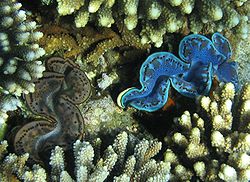
This list of molluscs of the Houtman Abrolhos includes 492 species of marine molluscs which have been recorded from the waters of the Houtman Abrolhos, an island group in the Indian Ocean off the coast of Western Australia.
Contents
These molluscs are predominantly gastropods (346 species, 70%) and bivalves (124, 25%); the remaining 5% of species consist of cephalopods (14 species), chitons (5 species) and scaphopods (4 species).
About two thirds of the species have a tropical distribution, temperate species account for 20%, and the remaining 11% are endemic to Western Australia. [1]
